Text
Anybody want to talk about how 5C control is the place to be? Like sometimes a faster deck can get under it before it is set up or sometimes you just don’t hit a color you need, but with so much good removal available, Golos ramp into free spells or Kenrith reanimator are just no fun to play against.
Though really this just emphasizes to me how Brawl is more enjoyable as a multiplayer format and less so as 1v1 on Arena.
1 note
·
View note
Text
36 It - Packaging a Brawl Deck
Props to @the8x8theory for their signature method of building a commander deck using 8 focused packages of 8 cards. Luckily we can piggyback off of them and use a similar method to build a Brawl deck. We’ve got a smaller deck though so we’re using fewer packages and fewer cards in each package. Instead of 8x8, we’re going 6x6 which will give us a deck with 36 cards. Throw in our commander and that leaves space for 23 lands*. Then we’re off to the races.
While this is a constructed format, in some ways it can play like a more powerful and streamlined limited environment. With that in mind, let’s start by looking at a common acronym used to guide limited deck building: BREAD. Bread means you focus on Bombs, Removal, Evasion/Efficient spells, Aggro, and Dregs. BRE is pretty useful. Aggro isn’t every deck’s MO but we’ll let this be a reminder that we do want to have some things we can do in the first few turns of the game, so don’t go too high on your mana curve. Dregs are something we don’t need to concern ourselves with since this is constructed--if you’re building a deck with cards you don’t want, you’re doing it wrong.
*Consider your deck’s mana curve and strategy. You may need more than 23 lands, in which case you will cut one of these 6 card packages down to fit them in.
With that in mind, let’s focus on BRE and build our first three packages. Each of these packages should default to 6 cards.
1. Bombs
What are your 6 most powerful cards? The 6 cards you’d want to see every game? The cards that put you ahead on the board, give big card advantage, and/or either push you toward securing the win or else bring you back from the brink of defeat? Those go here.
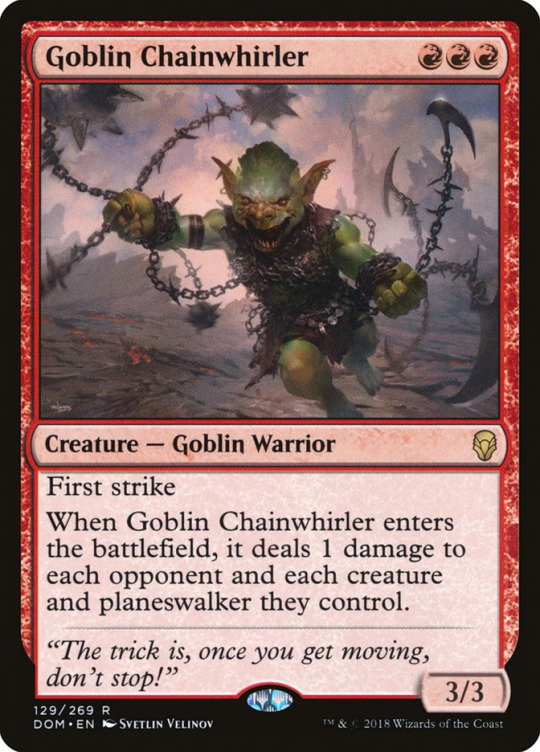
2. Removal
This is a multiplayer format so when you consider removal, consider both targeted and mass removal. Depending on your deck’s strategy, you may want two removal packages to help you control the game. This is one where you especially want to consider the meta. You don’t want to draw into a Naturalize a lot of the time, but if your opponent has Pacifism on your Dragon Mage then it could be the difference between a W and an L. In Brawl I tend to value more versatile removal over the most efficient removal. Thrashing Brontodon is a great option with that in mind. But of course what you’ll want most of is powerful creature removal. Never underestimate a well-timed and well-targeted Vraska’s Contempt.
3. Evasion/Efficient Spells
Boards can get really cluttered in a multiplayer game. If you can’t remove your opponents’ creatures, then you want to get around them. Big trampling creatures, fliers, and other evasion are the cards of the day here. This becomes even more true as players are eliminated and it’s down to you and one (hopefully weakened) opponent.
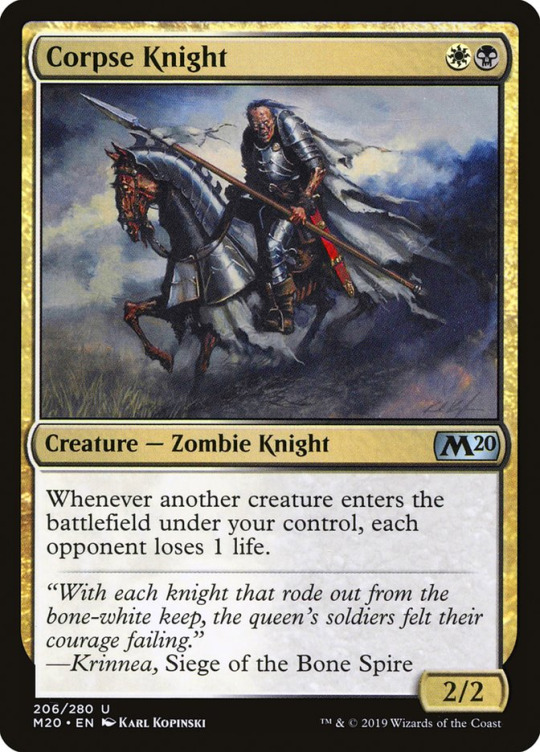
Efficient spells come at a good rate and can two-for-one or better for you. Corpse Knight is a fine creature in a 1-on-1 game. In a 4 person brawl it does three times more for you at the same rate! Arena is getting 1-v-1 Brawl support later this year, and you’ll want to build with that in mind. But when you have three opponents, pay extra attention to spells that say “each player” and especially to those that say “each opponent.”
4. Commander-Specific
This is why you’re playing Brawl. It’s not just to shove your deck full of bombs, but to build something that is fun to pilot with a specific commander and the cards that best synergize with that commander. I always try to include at least one full package of cards that I’d only ever play specifically with that commander. I’ll make exceptions here depending on what’s available, but for me this is where the deck really comes into its own and becomes something special.
Two More For the Road
Altogether that gives us four packages for 24 cards. For our last two packages I’d do the following:
a. A meta-specific package for cards that answer weaknesses in your deck, things which aren’t total dead draws but which are much stronger against specific decks (and honestly maybe one dead draw that can save the day if an opponent has a specific card that does see decent play), and otherwise just very niche cards you’d normally sideboard (since you don’t have a sideboard in Brawl)
b. Double up on any of the above packages. Add more removal, more bombs, or more toys that will really make your commander shine
Brawl is a constructed format, but the singleton nature means your available effects can be quite limited. You should expect to see a lot more bombs and removal than you’d ever see in limited. You should expect decks to be much more synergistic than you’d ever see in limited. But it plays like a limited environment in that players don’t often have more than one copy of a card--I say don’t often with regard to Brawl because being able to recur threats and spells is powerful and something most decks should seek to do.
Once you weather a threat, there is a decent chance it’s just gone from that game. This allows us to view Brawl from a different vantage than other formats. When coupled with building decks using packages, it gives us a quick and easy way to make sure a deck is sufficiently saturated with threats, removal, and support cards. At least enough to get things started and see what works and what doesn’t.
If you enjoyed this article, follow this blog to see more! Talk to me about Brawl through reblogs, replies, and asks. Have you built a deck with this method? Tell me about it!
10 notes
·
View notes
Text
In preparation of returning to brewing, here’s a reminder of what sort of stuff to look for when building reliable decks.
Redundancy
Brawl is a singleton format. Which means it has incredibly high variance and to make your deck dependable you need to figure out how to get the same effect multiple times or at least exactly when you most need it. There are three major ways to accomplish this.
1. Similar Cards
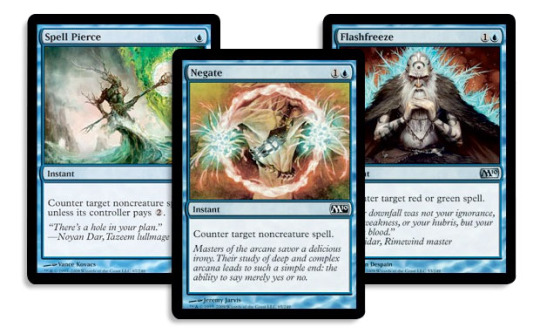
If you can’t have four copies of a card, the next best thing is four different cards that all do the same thing. Or even more, actually. The singleton counterspell suite I’ve grown fond of currently contains Negate, Essence Scatter, Cancel, Disallow, Supreme Will, and Syncopate. Any effect your deck is dependent on to execute its game plan should show up about as much as possible.
2. Recursion
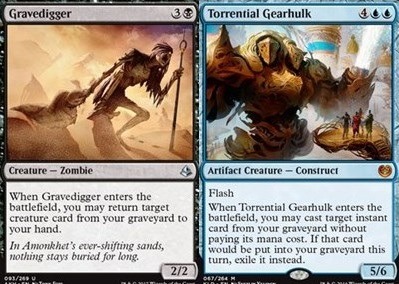
But what if “as much as possible” is just once? Maybe it’s a combo piece, or maybe it’s just a really powerful card and people know to counter or remove it as soon as possible. Well then you need to get it back. This will vary a great deal depending on the card in question, your colors, and just what you need from it. For example, Gravedigger can get back a creature for you to cast again, while Rise from the Grave can get it right back onto the battlefield if all you care about is getting an enters the battlefield trigger off of it.
3. Tutors
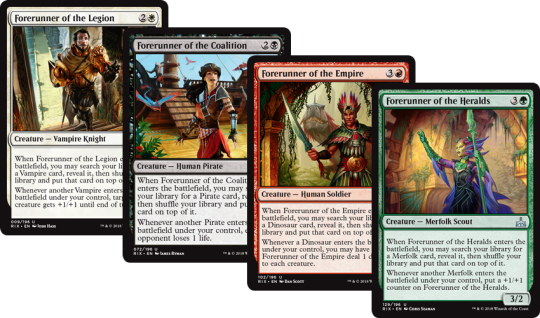
Black gets most of these and if you’re running a deck with black in it then you should seriously consider what tutors are available, though for the moment we’ve got the Forerunner cycle for tribes and a handful of other options. Running Diabolic Tutor is almost like having a second copy of every single card in your deck, just that this second copy costs 2BB more to cast. And while that’s a steep price tag, it’s nothing compared to the cost of losing a game because the card you need is nowhere to be found.
Knowing you can count on your deck to execute a particular plan will put you in the best position to win games. Redundancy is what you need for that.
25 notes
·
View notes
Text
While it’s not redundancy, card draw and filtering deserves an honorable mention here. If you can draw cards and scry through your deck, you’ll more likely be able to find what you need when you need it or just have more resources available for whatever comes your way. Though it’s not like I really need to tell you that drawing cards is good.
Redundancy
Brawl is a singleton format. Which means it has incredibly high variance and to make your deck dependable you need to figure out how to get the same effect multiple times or at least exactly when you most need it. There are three major ways to accomplish this.
1. Similar Cards

If you can’t have four copies of a card, the next best thing is four different cards that all do the same thing. Or even more, actually. The singleton counterspell suite I’ve grown fond of currently contains Negate, Essence Scatter, Cancel, Disallow, Supreme Will, and Syncopate. Any effect your deck is dependent on to execute its game plan should show up about as much as possible.
2. Recursion

But what if “as much as possible” is just once? Maybe it’s a combo piece, or maybe it’s just a really powerful card and people know to counter or remove it as soon as possible. Well then you need to get it back. This will vary a great deal depending on the card in question, your colors, and just what you need from it. For example, Gravedigger can get back a creature for you to cast again, while Rise from the Grave can get it right back onto the battlefield if all you care about is getting an enters the battlefield trigger off of it.
3. Tutors

Black gets most of these and if you’re running a deck with black in it then you should seriously consider what tutors are available, though for the moment we’ve got the Forerunner cycle for tribes and a handful of other options. Running Diabolic Tutor is almost like having a second copy of every single card in your deck, just that this second copy costs 2BB more to cast. And while that’s a steep price tag, it’s nothing compared to the cost of losing a game because the card you need is nowhere to be found.
Knowing you can count on your deck to execute a particular plan will put you in the best position to win games. Redundancy is what you need for that.
25 notes
·
View notes
Text
Wendy (Teferi), Zach (Bolas, the Ravager), and Brendan (Jhoira) had an epic confrontation where the entire secdon half of the game we basically hunkered down to keep Wendy from casting Approach of the Second Sun a second time. She was able to Cancel my Syncopate for the win.
I used my prize tix on 5 packs of Unstable. Time for the long drive home.
Played against @gavinverhey (Arcades) in round one and a guy named Sean (Raff). It was an intense match where Sean was at 1 life for a lot of it. Gavin and I threw some punches at each other before he knocked me out. Then Sean came out of nowhere with Lyra and Blackblade Reforged to win the round.
29 notes
·
View notes
Text
Oscar (Muldrotha) and Chris (creature Samut) played round 4 with me. Oscar handily destroyed the rest of us and we just couldn't answer the graveyard recursion from Muldrotha. Muldrotha is bad enough but he also had Eldest Reborn (he cast that twice), and The Scorpion God so he was grabbing our stuff from the grave as well as his own.
Played against @gavinverhey (Arcades) in round one and a guy named Sean (Raff). It was an intense match where Sean was at 1 life for a lot of it. Gavin and I threw some punches at each other before he knocked me out. Then Sean came out of nowhere with Lyra and Blackblade Reforged to win the round.
29 notes
·
View notes
Text
Round 3 was Edwin (Tatyova), Chris (creature Samut), and Andrew (GW Hautli).
I used my removal almost exclusively on Edwin and it turns out it should have been exclusively on him because he got a Nexus of the Fate infinite turn lock and eliminated the rest of us all at once.
Watching him take infinite turns was not fun. Should have been more explicit about saying hey guys, you are safe from me until we take him out.
Played against @gavinverhey (Arcades) in round one and a guy named Sean (Raff). It was an intense match where Sean was at 1 life for a lot of it. Gavin and I threw some punches at each other before he knocked me out. Then Sean came out of nowhere with Lyra and Blackblade Reforged to win the round.
29 notes
·
View notes
Text
Round 2 we had Robert (Slimefoot), Aaron (Hapatra), and Nick (Rashmi). Nick and Robert built up huge board positions then Nick took out Robert in the air. Aaron and I couldn't draw a wipe to clear things up so Nick dropped me and then Aaron.
Rashmi was a bit deceptive. It felt like there weren't many single big plays but it all added up to a huge board state that we couldn't take out. Robert's position looked more threatening for most of the game until Nick swung in. There was also a point where the proper play was to Hostage Taker my own Bolas and I missed it. It wouldn't have mattered but there you go.
Played against @gavinverhey (Arcades) in round one and a guy named Sean (Raff). It was an intense match where Sean was at 1 life for a lot of it. Gavin and I threw some punches at each other before he knocked me out. Then Sean came out of nowhere with Lyra and Blackblade Reforged to win the round.
29 notes
·
View notes
Text
Played against @gavinverhey (Arcades) in round one and a guy named Sean (Raff). It was an intense match where Sean was at 1 life for a lot of it. Gavin and I threw some punches at each other before he knocked me out. Then Sean came out of nowhere with Lyra and Blackblade Reforged to win the round.
29 notes
·
View notes
Text
Specifically for a format like Brawl that's definitely a card that can do great work for you in multiplayer. Not even to consider the additional value of modal spells in a singleton format.
Redundancy
Brawl is a singleton format. Which means it has incredibly high variance and to make your deck dependable you need to figure out how to get the same effect multiple times or at least exactly when you most need it. There are three major ways to accomplish this.
1. Similar Cards

If you can’t have four copies of a card, the next best thing is four different cards that all do the same thing. Or even more, actually. The singleton counterspell suite I’ve grown fond of currently contains Negate, Essence Scatter, Cancel, Disallow, Supreme Will, and Syncopate. Any effect your deck is dependent on to execute its game plan should show up about as much as possible.
2. Recursion

But what if “as much as possible” is just once? Maybe it’s a combo piece, or maybe it’s just a really powerful card and people know to counter or remove it as soon as possible. Well then you need to get it back. This will vary a great deal depending on the card in question, your colors, and just what you need from it. For example, Gravedigger can get back a creature for you to cast again, while Rise from the Grave can get it right back onto the battlefield if all you care about is getting an enters the battlefield trigger off of it.
3. Tutors

Black gets most of these and if you’re running a deck with black in it then you should seriously consider what tutors are available, though for the moment we’ve got the Forerunner cycle for tribes and a handful of other options. Running Diabolic Tutor is almost like having a second copy of every single card in your deck, just that this second copy costs 2BB more to cast. And while that’s a steep price tag, it’s nothing compared to the cost of losing a game because the card you need is nowhere to be found.
Knowing you can count on your deck to execute a particular plan will put you in the best position to win games. Redundancy is what you need for that.
25 notes
·
View notes
Text
Redundancy
Brawl is a singleton format. Which means it has incredibly high variance and to make your deck dependable you need to figure out how to get the same effect multiple times or at least exactly when you most need it. There are three major ways to accomplish this.
1. Similar Cards

If you can’t have four copies of a card, the next best thing is four different cards that all do the same thing. Or even more, actually. The singleton counterspell suite I’ve grown fond of currently contains Negate, Essence Scatter, Cancel, Disallow, Supreme Will, and Syncopate. Any effect your deck is dependent on to execute its game plan should show up about as much as possible.
2. Recursion

But what if “as much as possible” is just once? Maybe it’s a combo piece, or maybe it’s just a really powerful card and people know to counter or remove it as soon as possible. Well then you need to get it back. This will vary a great deal depending on the card in question, your colors, and just what you need from it. For example, Gravedigger can get back a creature for you to cast again, while Rise from the Grave can get it right back onto the battlefield if all you care about is getting an enters the battlefield trigger off of it.
3. Tutors

Black gets most of these and if you’re running a deck with black in it then you should seriously consider what tutors are available, though for the moment we’ve got the Forerunner cycle for tribes and a handful of other options. Running Diabolic Tutor is almost like having a second copy of every single card in your deck, just that this second copy costs 2BB more to cast. And while that’s a steep price tag, it’s nothing compared to the cost of losing a game because the card you need is nowhere to be found.
Knowing you can count on your deck to execute a particular plan will put you in the best position to win games. Redundancy is what you need for that.
25 notes
·
View notes
Text
‘Cause I know y’all are hanging on my every tweak of this deck, I’ve switched 2 mountains for 2 swamps. I run like five cards with red mana in it, two with double red costs if I keep Hour of Devastation in there. Which I probably will because while the Helm of the Host is great, it’s too much investment and being an artifact that needs creatures to function, it’s too easily answered after investing so much into it.
But back to the land trade, I have like 27 and 22 blue and black mana symbols in costs respectively (I don’t remember the exact count but it was close to that) and at least 6 of each of those are double costs. I can’t tell you how many times I had enough mana as far as CMC to drop a Liliana or even just an early Murder, but only one black mana source. Seemed to happen a lot less with blue mana for counterspells.
Anyway, there you go, and the whole thing is running better now.
Updated Nicol Bolas, the Ravager Deck List 8-22-2018
Still iterating on this with almost every spare moment I have and this is what I’m looking at now.
Keep reading
#I haven't been this invested in building and tuning a deck in a while#so this is a lot of fun#it's just such a unique experience
6 notes
·
View notes
Text
Yeah that makes sense. I'd lean toward adding more powerful cards over other stuff. Hopefully the standard stuff works really well with Muldrotha and then you only have about 20% of your deck that's really powered up so hopefully that balances out so it can provide a fun game, not blowing people out and not being totally overwhelmed itself. But I haven't actually done this with a deck so I don't have experience with it yet.
Concept
60 card Brawl deck and an additional 40 cards that are Commander legal so you can just shuffle those in and play classic EDH at a moment’s notice
13 notes
·
View notes
Text
Nice! How well does it perform in EDH mode?
Concept
60 card Brawl deck and an additional 40 cards that are Commander legal so you can just shuffle those in and play classic EDH at a moment’s notice
13 notes
·
View notes
Text
Concept
60 card Brawl deck and an additional 40 cards that are Commander legal so you can just shuffle those in and play classic EDH at a moment’s notice
#mtg brawl#like about 16 to 20 of them would need to be lands#depending on your 60 card build and commander#and then your base 60 isn't going to be quite as powerful as it could be#but it is quick and easy
13 notes
·
View notes
Text
Cards I’m considering:
Helm of the Host
Never//Return
Search for Azcanta
Arguel’s Blood Fast
Gilded Lotus
Walking Ballista
Spell Swindle
Rags//Riches
Of course to put any of these in, it would require cuts. And while a few of these I’d consider “better” than certain cards in my deck, I think they’re much less political options and I feel strongly that in a 4-person free-for-all it’s a mistake not to have political spells (more so than just any spell being political in so far as choosing targets goes).
I’m considering dropping my one board wipe (Hour of Devastation) in favor of Helm of the Host. Dropping a fresh new gearhulk or Bolas each turn demands an answer from them and likely lets me run away with the game if they don’t have it. Of course if I end up 1v1 against a token deck at the end of the game I may regret not having a board wipe available.
Oh, and the biggest switch I’m giving really legitimate thought to is dropping Divination and possibly even Liliana’s Contract in favor of Glimmer of Genius and Hieroglyphic Illumination. Switching my draw to instants means I get to keep mana open on other player’s turns for counters if necessary. I hope to play around with some of these options against a group tomorrow. We’ll see how much they’re willing to help me test.
Updated Nicol Bolas, the Ravager Deck List 8-22-2018
Still iterating on this with almost every spare moment I have and this is what I’m looking at now.
Keep reading
6 notes
·
View notes
Text
Updated Nicol Bolas, the Ravager Deck List 8-22-2018
Still iterating on this with almost every spare moment I have and this is what I’m looking at now.
CMDR: Nicol Bolas, the Ravager
Creatures: 10
Torrential Gearhulk
Gravedigger
The Scarab God
Nezahal, Primal Tide
Champion of Wits
Gonti, Lord of Luxury
Hostage Taker
Meteor Golem
Ravenous Chupacabra
Noxious Gearhulk
Other Spells: 24
Hour of Devastation
Vraska’s Contempt
Murder
Cast Down
Cut//Ribbons
Abrade
River’s Rebuke
Barals’ Expertise
Blink of an Eye
Helm of the Host
Liliana’s Contract
Divination
Chandra, Torch of Defiance
Liliana, Death’s Majesty
Switcheroo
In Bolas’ Clutches
Dark Intimations
Rise from the Grave
Supreme Will
Cancel
Essence Scatter
Negate
Disallow
Syncopate
Lands: 25
4x Island
4x Swamp
4x Mountain
Memorial to Genius
Memorial to Folly
Detection Tower
Evolving Wilds
Zhalfirin Void
Field of Ruin
Crypt of the Eternals
Spirebluff Canal
Drowned Catacomb
Sulfur Falls
Highland Lake
Cinder Barrens
Submerged Boneyard
6 notes
·
View notes